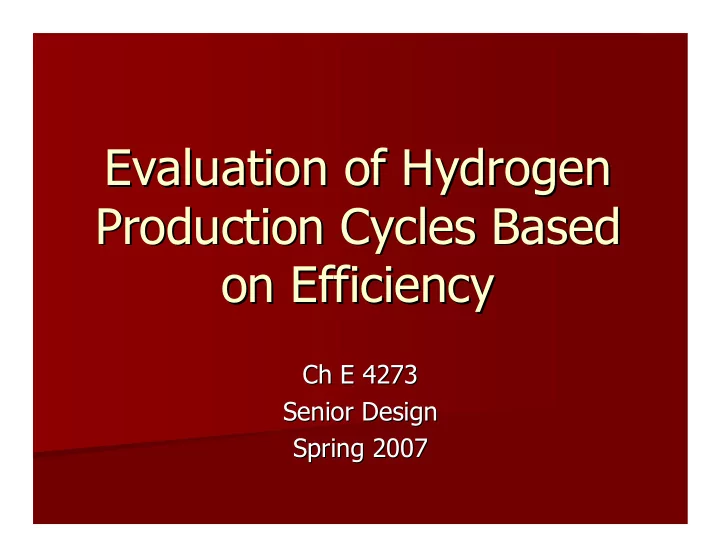

Evaluation�of�Hydrogen� Evaluation�of�Hydrogen� Production�Cycles�Based� Production�Cycles�Based� on�Efficiency on�Efficiency Ch�E�4273 Ch�E�4273 Senior�Design Senior�Design Spring�2007 Spring�2007
Purpose Purpose Develop�and�implement�a�method� Develop�and�implement�a�method� of�ranking�water# #splitting�cycles� splitting�cycles� of�ranking�water
Outline Outline � Importance�of�Hydrogen Importance�of�Hydrogen � � Thermochemical/Hybrid�Cycles� Thermochemical/Hybrid�Cycles� � � Current�Methods�of�Evaluation Current�Methods�of�Evaluation � � Our�Methodology�based�on�Efficiency Our�Methodology�based�on�Efficiency � � Results Results �
Hydrogen�Economy Hydrogen�Economy � Advantages Advantages � � Disadvantages Disadvantages � � Methods�for�producing�hydrogen Methods�for�producing�hydrogen � � Other�suggested�economy�types Other�suggested�economy�types �
Hydrogen�Economy Hydrogen�Economy � The�current�U.S.�demand� The�current�U.S.�demand� † � – 11�MM�tons/yr�total 11�MM�tons/yr�total – � Crude�lightening Crude�lightening � � Produce�cleaner Produce�cleaner# #burning�fuels burning�fuels � � Methanol/Ammonia�production Methanol/Ammonia�production � – Steam�reformation�of�methane Steam�reformation�of�methane – � Demand�in�Hydrogen�Economy� Demand�in�Hydrogen�Economy� † � – 200�MM�tons/yr�for�transportation 200�MM�tons/yr�for�transportation – – 450�MM�tons/yr�for�all�other�energy�needs 450�MM�tons/yr�for�all�other�energy�needs – � ����������������������������������������������
Water# #Splitting�Cycles Splitting�Cycles Water � � ⇔ + � � � � � � � � ����� ��!�����������!��������!��"���� � �����������������#���� � ������� ������$������!�%���&!�#������� ������������������'�$$�����
Water�Splitting�Cycles Water�Splitting�Cycles � Thermochemical�Cycles Thermochemical�Cycles � – Thermochemical�reactions�only Thermochemical�reactions�only – � Hybrid�Cycles Hybrid�Cycles � – Thermochemical�reactions Thermochemical�reactions – – Electrochemical�reactions Electrochemical�reactions – � Some�could�benefit�from�nuclear�plant�heat� Some�could�benefit�from�nuclear�plant�heat� � sources sources � Over�200�known�cycles Over�200�known�cycles �
Water�Splitting�Cycles Water�Splitting�Cycles � Thermochemical�Reactions Thermochemical�Reactions � – Established�equipment�in�industry Established�equipment�in�industry – – Often�require�high�temperatures Often�require�high�temperatures – � Electrochemical�Reactions Electrochemical�Reactions � – More�rare�in�industry More�rare�in�industry – – Difficult�to�implement Difficult�to�implement – – Occur�at�lower�temperatures Occur�at�lower�temperatures –
Water�Splitting�Cycle�Examples Water�Splitting�Cycle�Examples � Hallett�Air�Products�(hybrid) Hallett�Air�Products�(hybrid) � � + → + ���� � �� � � � ��� � � � � � → + ��� � � ��� �� � � � � US�Chlorine�(thermochemical) US�Chlorine�(thermochemical) � � + → + ���� � �� � � � ��� � � � � � → + ��� � � ���� � ���� �� � � + → + ��� � � ���� � ��� � ���� � � �
Water�Splitting�Cycle�Example Water�Splitting�Cycle�Example Hallett�Air�Products�(hybrid) Hallett�Air�Products�(hybrid)
Water�Splitting�Cycle�Example Water�Splitting�Cycle�Example US�Chlorine�(thermochemical) US�Chlorine�(thermochemical)
Issues Issues � Coupled�reactions Coupled�reactions � – Cyclic�Process Cyclic�Process# # Degrees�of�freedom Degrees�of�freedom – � Special�reaction�methods�(high� Special�reaction�methods�(high� � � G>0) G>0) � – Electrolysis� Electrolysis� – – Continuous�product�removal Continuous�product�removal – � Reaction�Equilibrium Reaction�Equilibrium � – Reversibility Reversibility – – Equilibrium�conversion Equilibrium�conversion – � Separation�Energy�(heat�and�work)�may� Separation�Energy�(heat�and�work)�may� � complicate�the�flowsheet flowsheet complicate�the�
Prior�Evaluation�Efforts Prior�Evaluation�Efforts � L.C.�Brown�(2000,�DOE)�scored�cycles� L.C.�Brown�(2000,�DOE)�scored�cycles� � based�on�known�characteristics based�on�known�characteristics – Qualitative�approach Qualitative�approach – – Questionable�evaluation�technique Questionable�evaluation�technique – � Point�system�for�process�complexities Point�system�for�process�complexities � � Equal�weighting�assigned�to�all�criteria Equal�weighting�assigned�to�all�criteria � � “Judgment�call”�basis “Judgment�call”�basis � � Heavily�favors�well Heavily�favors�well# #researched�cycles researched�cycles �
Prior�Evaluation�Efforts Prior�Evaluation�Efforts
Prior�Evaluation�Efforts Prior�Evaluation�Efforts � Lewis�(2005,�DOE)�evaluated�cycles�based� Lewis�(2005,�DOE)�evaluated�cycles�based� � on�efficiency on�efficiency – Quantitative�approach Quantitative�approach – – Considers�equilibrium Considers�equilibrium – – Assumes�50%�efficiency�for�all�work�processes Assumes�50%�efficiency�for�all�work�processes – � Actual�efficiency�may�be�better�or�worse Actual�efficiency�may�be�better�or�worse � � Different�processes�have�different�efficiencies Different�processes�have�different�efficiencies �
Our�Proposed�Solution Our�Proposed�Solution Efficiency�Based�Ranking�System: Efficiency�Based�Ranking�System: � Find�maximum�possible�efficiency Find�maximum�possible�efficiency � – Pinch�technology�to�determine�hot�utility Pinch�technology�to�determine�hot�utility – � Stream�analysis Stream�analysis � � Heat�of�reaction Heat�of�reaction � – Estimate�work�required Estimate�work�required – � Consider�reaction�equilibrium Consider�reaction�equilibrium � � DOF:�optimize�flow�rates�and� DOF:�optimize�flow�rates�and� � temperatures temperatures
Cycle�Efficiency Cycle�Efficiency ( ) � ° � ��� � � � η = − � + � � � Enthalpy�of�formation�of�water�is�minimum� Enthalpy�of�formation�of�water�is�minimum� � energy�required�for�water# #splitting splitting energy�required�for�water
Cycle�Efficiency Cycle�Efficiency � Only�heat�and�work�transferred�across� Only�heat�and�work�transferred�across� � system�boundary�included system�boundary�included � Heat�term Heat�term � – Hot�utility Hot�utility – – Heat�for�separations Heat�for�separations – � Work�term� Work�term� � – Pump/compressor�work Pump/compressor�work – – Electrical�work�in�electrolysis Electrical�work�in�electrolysis –
Equilibrium Equilibrium ( ) ∑ � = ν � ° + � �� �� � � � � Setting� � G RXN equal�to�zero�gives�the�following, � ° � = − � ��� ��� �� �� ∏ ν = � � � �� �
Equilibrium Equilibrium � Sulfur�Iodine� Sulfur�Iodine�– – Reaction�1�(1123�K) Reaction�1�(1123�K) � � → + + ���� � � �� � � � �� � � � � � � � � � � � � � � � � � � ⋅ � � � � � � � � � �� � � � = � � � � � � � � � + + + � � � � � � � � � � � �� � �� �� � � � � � � � � � � � Relate�number�of�moles�to�conversion� Relate�number�of�moles�to�conversion� � ⇒ = � � � � � � � � � � � � n i =�n n i,o +� ν ν i X i n i =� i,o +� i X i � �
Recommend
More recommend